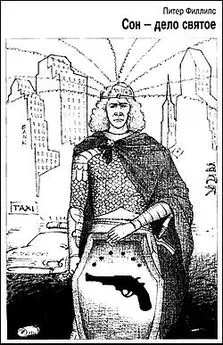Питер Шпорк - Сон. Почему мы спим и как нам это лучше всего удается
- Название:Сон. Почему мы спим и как нам это лучше всего удается
- Автор:
- Жанр:
- Издательство:Бином. Лаборатория знаний
- Год:2010
- Город:Москва
- ISBN:978-5-94774-772-0
- Рейтинг:
- Избранное:Добавить в избранное
-
Отзывы:
-
Ваша оценка:
Питер Шпорк - Сон. Почему мы спим и как нам это лучше всего удается краткое содержание
Немецкий нейрофизиолог и популяризатор науки Петер Шпорк обсуждает вопросы, актуальные для многих категорий населения. Жизнь современного человека полна стрессов, из-за чего нередко возникают нарушения сна. Почти все пациенты психиатров и многие люди, страдающие соматическими расстройствами, имеют проблемы со сном. Автор в доступной и ясной форме рассказывает о физиологических механизмах сна, различных проявлениях нарушений сна, сне у животных, обучении во сне и предлагает ряд тестов для выявления и коррекции некоторых нарушений этой функции. В книге приводятся самые последние научные данные, она снабжена библиографией.
Книга вызовет интерес у исследователей-сомнологов и у практикующих врачей, а также у всех, интересующихся этой тематикой.
Сон. Почему мы спим и как нам это лучше всего удается - читать онлайн бесплатно ознакомительный отрывок
Интервал:
Закладка:
Dement, C., und Vaughan, C.: Der Schlaf und unsere Gesundheit. Limes, Miinchen 2000.
DhahbiJ. М., Kim, H.-J., und andere: Temporal linkage between the pheno-typic and genomic responses to caloric restriction. Proceedings of the National Acadamy of Sciences of the USA 101, S. 5524–5529, 2004.
Dinges, D. F, Rogers, N. L., und Baynard, M. D.: Chronic Sleep Deprivation. In: Principles and Practice of Sleep Medicine, 4th Edition, М. H. Kryger, T. Roth, W. C. Dement (Hrsg.). Elsevier Saunders, Philadelphia 2003. S. 67–76.
D ö rr, C, Maisel, P., und andere: Aus dem Lebenslauf einer hausarztlichen Leitlinie. Zeitschrift fur Allgemeinmedizin 82, S. 219–222, 2006.
Dunlap, J. C., Loros, J.J., und DeCoursey, P.J.: Chronobiology: biological timekeeping. Sinauer, Sunderland 2004.
Eiland, М. М., Lyamin, О. I. und Siegel, J. М.: State-related discharge of neurons in the brainstem of freely moving box turtles, Terrapene Carolina major. Archives of Italian Biology 139, S. 23–36, 2001.
Etzold, S.: Die Globalisierung des Nickerchens. Die Zeit 34, S. 32, 12.8.2004.
Everson, С. A., und Toth, L A.: Systemic bacterial invasion induced by sleep deprivation. American journal of physiology. Regulatory, integrative and comparative physiology 278, S. R905-R916, 2000.
Fenn, К. М., Nusbaum, H. C., und Margoliash, D.: Consolidation during sleep of perceptual learning of spoken language. Nature 425, S. 614 bos 616, 2003.
Fischer, J., Mayer, G., und andere: Leitlinien der Deutschen Gesellschaft flir Schlafforschung und Schlafmedizin: Nicht-erholsamer Schlaf. AWMF-Online, 2004. www.uni-duesseldorf.de/AWMF/ll/063-001. htm#kap3 (Zugriff: 4.7.2006)
Frank; M. G., Issa, M. P., und Stryker, M. P.: Sleep Enhances Plasticity in the Developing Visual Cortex. Neuron 30, S. 275–287, 2001.
Gais, S., Plihal, W., und andere: Early sleep triggers memory for early visual discrimination skills. Nature Neuroscience 3, S. 1335–1339, 2000.
Gallopin, Т., Luppi, P. H., und andere: Effect of the wake-promoting agent Modafinil on sleep-promoting neurons from the ventrolateral preoptic nucleus: an in vitro pharmacologic study. Sleep 27, S. 19–25, 2004.
Geiger; S.: Die Deutschen sind ein mudes Volk. Frankfurter Allgemeine Zeitung 169, S. 7, 2002.
Gerste, R. D.: «Gentlemen, dies ist kein Hum bug!» Die Zeit, 18.10.1996, S. 17.
Goode, E.: Why do we sleep? The New York Times, 11.11. 2003.
Greenspan, R.J., Tononi, G., und andere: Sleep and the fruit fly. Trends in Neuroscience 24, S. 142–145, 2001.
gün: Viel Licht am Tag fordert Nachtschlaf bei Demenz. Ärztezeitung, 25.11.2003.
Gundely A.y Rönicke, J., und ten Thoren, C.: Wach und unfallfrei ans Ziel. DLR-Nachrichten 113, S. 34–37, 2006.
Herxheimer, A., und Waterhouse, J.: The prevention and treatment of jet lag. British Medical journal 326, S. 296–297, 2003.
Hobson, A.: Sleep is of the brain, by the brain and for the brain. Nature 437, S. 1254–1256,2005.
Huber, R., Hill, S. L., und andere: Sleep Homeostasis in Drosophila Melanogaster. Sleep 27, S. 628–639, 2004.
Huber, R., Ghilardi, M. F., und andere: Local sleep and learning. Nature 430, S. 78–81,2004.
Kattler, H., Dijk, D.-J., und Borbely, A. A.: Effect of unilateral somatosensory stimulation prior to sleep on the sleep EEG in humans, journal of Sleep Research 3, S. 159–164,1994.
Kaulen, H:. Schlummern mit Wonne. Frankfurter Allgemeine Zeitung 165, S.N1,19.7.2006.
Khatami, R., und Bassetti C. L.: Narcolepsy. Schweizer Archiv fiir Neurologie und Psychiatrie 154, S. 339–357, 2003.
Kramer, A., Yang, F.-C., und andere: Regulation of daily locomotor activity and sleep by hypothalamic EGF receptor signaling. Science 294, S. 2511–2515, 2001.
Kräuchi, K., Cajochen, C., und andere: Warm feet promote the rapid onset of sleep. Nature 401, S. 36–37,1999.
Kräuchi, K, Cajochen, C., und andere: Thermoregulatory effects of melatonin in relation to sleepiness. Chronobiology International 23, 475–484, 2006.
Kripke, D. F., Garfinkel, L., und andere: Mortality associated with sleep duration and insomnia. Archives of General Psychiatry 59, S. 137–138,2002.
Kunz, D., Schmitz, S., und andere: A New Concept for Melatonin Deficit: On Pineal Calcification and Melatonin Excretion. Neuropsychopharmacology 21, S. 765–772,1999.
Kunz, D., Mahlberg, R., und andere: Melatonin in Patients with Reduced REM Sleep Duration: Two Randomized Controlled Trials. The Journal of Clinical Endocrinology Metabolism 89, S. 128–134, 2004.
Lange, Т., Perras, B., und andere: Sleep Enhances the Human Antibody Response to Hepatitis A Vaccination. Psychosomatic Medicine 65, S. 831–835, 2003.
Lavie, P.: Die wundersame Welt des Schlafes, dtv, MUnchen 1999.
Leuschner, W.: Ende der Traumforschung. Frankfurter Allgemeine Zeitung 91, S. N3, 19.4.2006.
Lo, C.-C., Chou, Т., und andere: Common scale-invariant patterns of sleepwake transitions across mammalian species. Proceedings of the National Acadamy of Sciences of the USA 101, S. 17 545-17 548, 2004.
Lu,Sherman, D., und andere: A putative flip-flop switch for control of REM sleep. Nature 441, S. 589–594, 2006.
Lyamin, O., Pryaslova, J., und andere: Continuous activity in cetaceans after birth. Nature 435, S. 1177, 2005.
Mahowald, M. W., und Schenck, С. H.: REM sleep behavior disorder — past, present, and future. Schweizer Archiv fur Neurologie und Psychiatrie 154, S. 363–368, 2003.
Mahowald, M. W., und Schenck, С. H.: Insights from studying human sleep disorders. Nature 437, S. 1279–1285, 2005.
Marschall, L., Helgadottir, H., und andere: Bosting slow oscillations during sleep potentiates memory. Nature AOP, doi: 10.1038/natur 05278, 5.11.2006.
Maquet, P.: Sleep on it! Nature Neuroscience 3, S. 1235–1236, 2003.
Markowitsch, H.-J.: Dem Gedachtnis auf der Spur. Primus Verlag, Darmstadt 2002.
Max, D. Т.: The family that couldn’t sleep. Random House, New York 2006.
Mayer, G.: Narkolepsie: Genetik — Immungenetik — motorische Storungen. Blackwell Wissenschafts-Verlag, Berlin 2000.
Mayer, G.: NREM parasomnias. Schweizer Archiv fur Neurologie und Psychiatrie 154, S. 358–362, 2003.
Meier-Koll,A.: Chronobiologie. С. H. Beck, Miinchen 1995.
Mertens, W.: Traum und Traumdeutung. С. H. Beck, Miinchen 2003.
Mostaghimi, L., Obermeyer, W. H., und andere: Effects of sleep deprivation on wound healing. Journal of Sleep Research 14, S. 213–219, 2005.
Mouritsen, H., und Frost, B.).: Virtual migration in tethered flying monarch butterflies reveals their orientation mechanisms. Proceedings of the National Academy of Sciences of the USA 99, S. 10162-10166, 2002.
Nelson, L. E., Guo, T. Z., und andere: The sedative component of anaesthesia is mediated by GABAA receptors in an endogeneous sleep pathway. Nature Neuroscience 5, S. 979–984, 2002.
Nielsen, T. A., und Stenstrom, P.: What are the memory sources of dreaming? Nature 437, S. 1286–1289, 2005.
Nitz, D. A., van Swinderen, B., und andere: Electrophysiological Correlates of Rest and Activity in Drosophila melanogaster. Current Biology 12, S. 1934–1940, 2002.
nsi/Rö: Nachts wach und tagsuber kaputt — Schlafstorungen nerven viele Menschen. Arztezeitung, 13.7.2000.
Opp, М. R ., und Toth, L. A: Neural-immune interactions in the regulation of sleep. Frontiers in bioscience 8, S. 768–779, 2003.
Paavonen, E. J., Pennonen, М., und andere : TV exposure associated with sleep disturbances in 5- to 6-year-old children. Journal of Sleep Research 15, S. 154–161,2006.
Penzely Т.: Schlafstörungen und ihre Behandlungsmethoden, web.unimarburg.de/sleep//dgsm/rat/welcome.html (Zugriff: 6.7.2006).
Penzely Т., Peter, H., und Peter, J. H.: Gesundheitsberichterstattung des Bundes, Heft 27. Robert Koch-Institut, Berlin 2005.
Rajaratnam, S. M. W., und Arendt J.: Health in a 24-h society. Lancet 358, S. 999-1005, 2001.
Ramón, F., Hernández-Falcon, J., und andere: Slow wave sleep in crayfish. Proceedings of the National Acadamy of Sciences of the USA 101, 11857-11861,2004.
Rattenborg, N. C., Lima, S. L., und Amlaner, C.J. : Facultative control of avian unihemispheric sleep under the risk of predation. Behavioural brain research 105, S. 163–172, 1999.
Rattenborg, N. C., Mandt, В. H., und andere: Migratory Sleeplessness in the White-Crowned Sparrow (Zonotrichia leucophrys gambelii). PLoS Biology 2, S. 924–936, 2004.
ref: Mitarbeiter der Woche: Der Arzt der Arzte. Der Tagesspiegel 19171, S. 14, 24.4.2006.
Rechtschaffen, ABergmann, В. М., und andere: Sleep deprivation in the rat: X. Integration and discussion of the findings. Sleep 12, S. 68–87,1989.
Rechtschaffen, A., und Siegel, J. М.: Sleep and Dreaming. In: Principles of Neuroscience. 4th Edition. E. R. Kandel, J. H. Schwartz, Т. M. Jessel (Hrsg.). McGraw-Hill, New York 2000, S. 936–947.
Rechtschaffen, A., und Kales, A.: Ein Manual der standardisierten Terminologie, Techniken und Auswertung der Schlafstadien beim Menschen. Ecomed, Landsberg 2002.
Rétey, J. V., Adam, М., und andere: A functional genetic variation of adenosine deaminase affects the duration and intensity of deep sleep in humans. Proceedings of the National Acadamy of Sciences of the USA 102, S. 15676-15681,2005.
Reyner, L.A., und Horne, J. A.: Suppression of sleepiness in drivers: Combination of caffeine with a short nap. Psychophysiology 34, S. 721 bis 725, 1997.
Ritzert, В.: Wenn die «innere Uhr» nicht richtig tickt. Informationsdienst Wissenschaft, 10.07.2006.
Rohrs, C.-F.: Der Arzt im Paradies. Der Tagesspiegel 19171, S. 3,24.4.2006.
Roenneberg, Т., Wirz-Justice, A., und Merrow, М.: Life between clocks: Daily temporal patterns of human chronotypes. lournal of Biological Rhythms 18, S. 80–90, 2003.
Roenneberg, Т., Kuehnle, Т., und andere: A marker for the end of adolescence. Current Biology 14, S. R1038-R1039, 2004.
Rosen, I. М.: Driving While Sleepy Should Be A Criminal Offense.)ournal of Clinical Sleep Medicine 1, S. 337–340, 2005.
rpo: Warum Vogel beim Schlafen nicht vom Baum fallen. RP-Online, 5.7.2004.
Sabo, E.: Combat leaves soldiers ‘drunk’ with fatigue, www.newscientist.com/article.ns?id=dn3604(Zugriff 7.6.2006).
Sacks, O.: Awakenings: Zeit des Erwachens. Rowohlt, Reinbek 1991.
Saper, С. B., und Scammell, Т. E.: Modafinil: A Drug in Search of a Mechanism. Sleep 24, S. 11–12, 2004.
Saper, С. B., Scammell, Т. E., undLu,).: Hypothalamic regulation of sleep and circadian rhythms. Nature 437, S. 1257–1263, 2005.
Schafer, J.: Schnarchen, Schlafapnoe und obere Luftwege. Thieme, Stuttgart 1996.
Scheer, F. A., Van Montfrans, G. A., und andere: Daily nighttime melatonin reduces blood pressure in male patients with essential hypertension. Hypertension 43, S. 192–197, 2004.
Schwender, D., Madler, C., und andere: Do auditory evoked potentials measure depth of anaesthesia? Theoretical Surgery 8, S. 29–37,1993.
Читать дальшеИнтервал:
Закладка:









